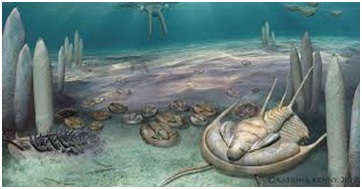Name: Cambrian
Era: 541-485.4 m.y.a
Average Temperature: 21 Celsius
Atmospheric oxygen: 12.5%

So, after the Proterozoic, when life was at its early stages and was simple, the Cambrian introduced the first true ancestors of animals, animals which move, hunt, and seem like actual beasts. Of course, all of it was aquatic. Why is that? Well, remember all those glaciers in the Proterozoic? Those melted and brought the sea level RIDICULOUSLY high. Everything was warm, and the conditions were ideal for diversification of life into more complex structures. There was land, after the whole tectonic plate formation WAY back in the Hadean, the land had been rising out of the mantle. This big piece of land was called Gondwana, and it basically covered the South of the Earth. It was what would eventually become most of Asia, England, Antarctica, Australia, and, of course, Florida. (Maybe that is why everyone from Florida is so OUTLANDISH.) The rest of soon-to-be America was on an island called Laurentia, and some other islands were soon-to-be countries, like Siberia.
The Cambrian Explosion. A life-changing event. Literally. No, LITERALLY. Like, it actually changed life. This was life’s experimentation phase, where it just played around to see what would work, and what looked cool. Many strange animals appeared here. There were also animals with skeletons, and animal which could burrow. Why did the happen? Well, first off, there was more oxygen; the ozone formed, which prevented everything from getting RADIATION POISONING; the glaciers killed basically everything else, which freed up niches for animals; the increased calcium in the saltwater let them create bones; Hox genes, which basically decide where each body part goes; and of course, the food chain, which started the race between prey and predator to one-up each other, the prey becoming harder to kill, and the predator making it harder for the prey to not be dead (It’s complicated).
Most of the animals were arthropods, which are basically the class which contains insects and arachnids (Class, phyla, genus, it was one of them, Okay, I don’t remember!). Like the Treptichnus pedum, a burrowing creature and an ancestor to marine worms. Similarly, the Conodonta was an eel-like creature whose fossils were used to separate these very eons. One of the most classic Cambrian animals is the Trilobita, a burrowing ancestor to the hermit crab. Myollokunmingia resembled a fish and was newest of the first creatures to have a (relatively) complete skeleton. The Anomalocaris was a close relative to insects. It was a predator which could grow up to a metre, its eyes were as powerful as the compounded eyes of today’s insects, and it had two stalks protruding from its mouth with sharp teeth on the end. Pikaia was a worm-like eel thing, which was one of the first creatures to have a spine, and so was very important. A strange one was Opabinia, who had five eyes, a mouth under the head, and a proboscis like tentacle. This diverse font of life is an important part of what was yet to come.
Shaurya Prasad ( Grade 7A )